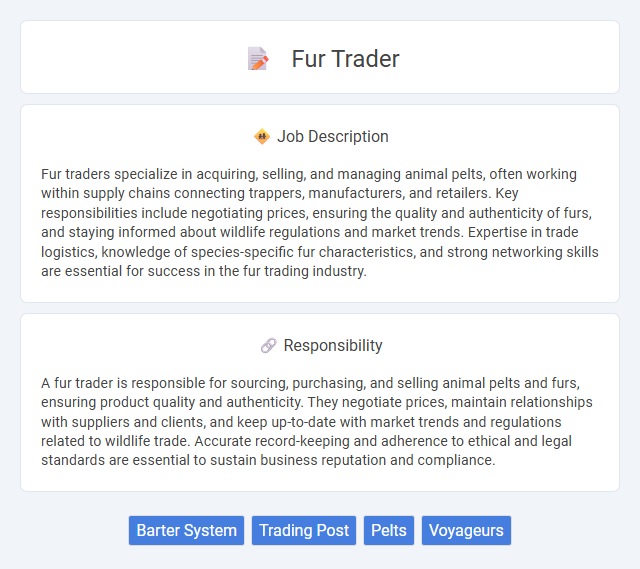
Fur traders specialize in acquiring, selling, and managing animal pelts, often working within supply chains connecting trappers, manufacturers, and retailers. Key responsibilities include negotiating prices, ensuring the quality and authenticity of furs, and staying informed about wildlife regulations and market trends. Expertise in trade logistics, knowledge of species-specific fur characteristics, and strong networking skills are essential for success in the fur trading industry.
Fur traders often face harsh outdoor conditions, including extreme weather and long hours of physically demanding work, which may not suit individuals with limited stamina or a preference for indoor environments. Those with strong survival skills, resilience, and a tolerance for isolation are more likely to thrive in this role. The probability of success increases for candidates who enjoy adventure and can adapt to unpredictable situations.
Qualification
Fur traders require a strong understanding of market trends, negotiation skills, and knowledge of animal pelts and quality grading. Qualifications include experience in trade, supply chain management, or wildlife conservation, alongside certifications in relevant fields such as business or environmental studies. Proficiency in regional and international trade regulations enhances a fur trader's ability to operate effectively in global markets.
Responsibility
A fur trader is responsible for sourcing, purchasing, and selling animal pelts and furs, ensuring product quality and authenticity. They negotiate prices, maintain relationships with suppliers and clients, and keep up-to-date with market trends and regulations related to wildlife trade. Accurate record-keeping and adherence to ethical and legal standards are essential to sustain business reputation and compliance.
Benefit
Fur trader jobs likely offer financial benefits through commission-based earnings and access to rare, high-value pelts. Employees may benefit from developing deep knowledge in wildlife trade and negotiation skills. Opportunities for travel and networking within niche markets can further enhance career growth and income potential.
Challenge
Fur trader jobs likely involve navigating fluctuating market demands and unpredictable supply chains, presenting significant challenges in inventory management and pricing strategy. Adapting to regulatory changes and environmental concerns may complicate sourcing practices, increasing operational risk. Success in this role probably depends on strong negotiation skills and resilience in a competitive, often volatile industry.
Career Advancement
A fur trader career offers opportunities for advancement through gaining expertise in supply chain management, market analysis, and negotiation skills. Progression typically involves moving from entry-level trading roles to senior positions such as trading managers, procurement specialists, or business development directors within the fur and luxury goods industry. Building strong networks with suppliers, understanding global market trends, and developing financial acumen are critical for career growth in the fur trading sector.
Key Terms
Barter System
Fur traders operated primarily within the barter system, exchanging animal pelts such as beaver, fox, and mink for essential goods like tools, weapons, and textiles. This trade network relied on direct, negotiated exchanges without standardized currency, emphasizing the value of quality furs in securing diverse commodities. The barter system facilitated economic relationships between Indigenous peoples and European settlers, driving the growth of North American fur trade markets.
Trading Post
Fur traders operated at trading posts where they exchanged goods such as metal tools, weapons, and fabric for animal pelts from Indigenous peoples and trappers. These posts served as critical hubs for commerce, facilitating the fur trade economy and enabling cultural interactions between European settlers and native communities. Efficient management of inventory and negotiation skills were essential for success in maintaining profitable trading post operations.
Pelts
Fur traders specialized in sourcing and trading pelts from animals such as beavers, foxes, and minks, which were highly valued in the fashion and textile industries. Expertise in identifying high-quality pelts and understanding seasonal variations in fur texture and durability was essential for maximizing profit. Successful fur traders built networks with trappers, indigenous peoples, and markets to ensure a steady supply and demand for premium pelts.
Voyageurs
Voyageurs were skilled fur traders who navigated vast waterways, transporting valuable pelts such as beaver and otter across North America during the fur trade era. Their expertise in canoe handling and knowledge of indigenous trade routes enabled efficient exchange between remote trading posts and European markets. These traders played a crucial role in expanding commerce and cultural connections throughout the fur trade network.
 kuljobs.com
kuljobs.com